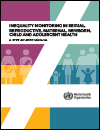What's New
Displaying results 351 - 360 of 4913

Resource | Publications,
Monitoring inequalities in sexual, reproductive, maternal, newborn, child and adolescent health (SRMNCAH) is an important part of efforts to promote equity. Inequality monitoring in sexual, reproductive, maternal, newborn, child and adolescent health: a step-by-step manual serves as a practical introductory guide to strengthen and build capacity for quantitative inequality monitoring in SRMNCAH. Applying the five steps of health inequality monitoring to the topic of SRMNCAH, the manual outlines the processes of: (1) determining the scope of monitoring; (2) deciding upon the best available data; (3) performing data analysis; (4) reporting findings; and (5) translating knowledge into action. The technical content of the manual is primarily written and designed for those involved in national SRMNCAH monitoring and evaluation efforts, including officers and programme managers who have basic knowledge and experience working with SRMNCAH data.

Resource | Reviews and Snapshots,
The prevention scorecard measures and tracks prevention progress in India, including on indicators for each of the five prevention pillars as relevant to country context. Each score is based on a combination of two dimensions: outcome, and coverage.

Resource | Reviews and Snapshots,
The prevention scorecard measures and tracks prevention progress in Indonesia, including on indicators for each of the five prevention pillars as relevant to country context. Each score is based on a combination of two dimensions: outcome, and coverage.

Resource | Reviews and Snapshots,
The prevention scorecard measures and tracks prevention progress in Iran, including on indicators for each of the five prevention pillars as relevant to country context. Each score is based on a combination of two dimensions: outcome, and coverage.

Resource | Reviews and Snapshots,
The prevention scorecard measures and tracks prevention progress in Myanmar, including on indicators for each of the five prevention pillars as relevant to country context. Each score is based on a combination of two dimensions: outcome, and coverage.

Resource | Reviews and Snapshots,
The prevention scorecard measures and tracks prevention progress in Pakistan, including on indicators for each of the five prevention pillars as relevant to country context. Each score is based on a combination of two dimensions: outcome, and coverage.

Resource | Reviews and Snapshots,
This poster illustrate the state of HIV prevention in India with detailed data on key populations, policy and structural barriers, HIV programme coverage and outcomes, HIV prevention adaptations during COVID-19, linkages between HIV and sexual and reproductive health services, antiretroviral drug-based prevention and the status of implementation of prevention 2020 roadmap.

Resource | Reviews and Snapshots,
This poster illustrate the state of HIV prevention in Indonesia with detailed data on key populations, policy and structural barriers, HIV programme coverage and outcomes, HIV prevention adaptations during COVID-19, linkages between HIV and sexual and reproductive health services, antiretroviral drug-based prevention and the status of implementation of prevention 2020 roadmap.

Resource | Reviews and Snapshots,
This poster illustrate the state of HIV prevention in Islamic Republic of Iran with detailed data on key populations, policy and structural barriers, HIV programme coverage and outcomes, HIV prevention adaptations during COVID-19, linkages between HIV and sexual and reproductive health services, antiretroviral drug-based prevention and the status of implementation of prevention 2020 roadmap.

Resource | Reviews and Snapshots,
This poster illustrate the state of HIV prevention in Myanmar with detailed data on key populations, policy and structural barriers, HIV programme coverage and outcomes, HIV prevention adaptations during COVID-19, linkages between HIV and sexual and reproductive health services, antiretroviral drug-based prevention and the status of implementation of prevention 2020 roadmap.





